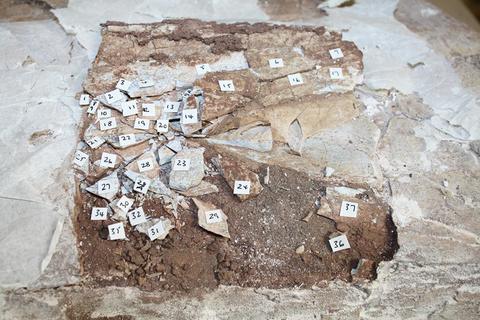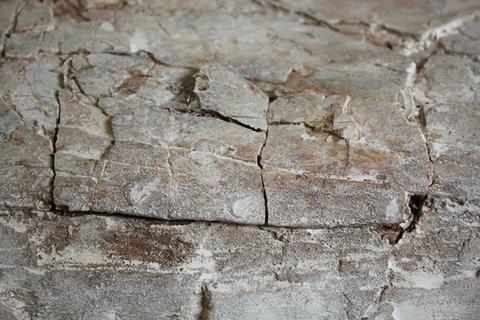
Fragmented bone surface on a sauropod femur. Photo and labelling by Mark Graham.
In the last Niger Sauropod post, we looked at the removal of rock and other material from the bones. Unfortunately for us, fossils are frequently fragile things that have often suffered some damage, whether this be a result of the fossilisation process itself, weathering or even being trodden on by large animals.
Our sauropod skeleton was discovered weathering out of the Sahara Desert, and perhaps not surprisingly, is not in the best possible condition. As we work on the bones, we do what we can to repair them- consolidating fragmentary sections, filling gaps and cracks, and fixing major breaks.
Much of this work is done using an adhesive called Paraloid B72. Although a little hard to handle and manipulate, it forms a very strong bond and, as it is soluble in acetone, is reversible. Thinned down solutions of Paraloid can be dripped into cracks or onto fragmented bone surface to consolidate them, while major breaks can be repaired with thicker solutions. Large bones can be left upright in the lab’s sandpit, supported by sandbags and clamps, while the adhesive sets.

Paraloid can also form the base of a gap-filling material- by mixing it with tiny glass beads, each only a fraction of a millimetre in diameter, a thick paste can be produced and used to fill large cracks and gaps in the specimen.
Putting these bones back together can be an incredibly fiddly and time-consuming job, but there’s nothing like the feeling of finding the right place for that little fragment of bone you’ve been turning around and around like a Tetris block for an hour or more……..
UPDATE: Fossil preparator extraordinairre Mark Graham has somehow managed to fix the nightmarish mess pictured above! Check it out: 
Kieran Miles writes for the Conservation Centre website. He’s OK at jigsaws but has never successfully completed a Rubik’s cube.

Comments
pYkXdyxGmmXYoouU
Thanks for the heads-up on this phishing therad, Edward, it's very interesting reading. (Did I just call a security therad interesting? What is happening to me???)It strikes me, though, that beyond (potentially) spoofing someone's identity in comments on a blog, there isn't much that can be done with a stolen OpenID identity? Also, since it is in the nature of phishing attacks that the phisher has little or no control over whose identity is being hijacked, it makes the value of impersonating J. Random Blog-Commenter moot. Or am I missing something important?
PdRXCXKvYhVQNNrXC
Hi everyone,Since over a year has pasesd since we published this post, we're closing the comments to help us focus on the work ahead. If you still have a question or comment you'd like to discuss, free to visit and/or post your topic in our .Thanks and take care,The Webmaster Central Team
FbrhsFmeiy
Hi, I really need some help paesle. I need to contact google as my page rank has been reduced to zero, however, I can't contact them as I can't verify my site - does anyone know what I should do?
GRDnVrLfBSors
I agree that having a govnmerent standard is important to things like log in, but as technology is progressing, will the govnmerent be able to update its standards as fast as hackers are updating their techniques? I think that the govnmerent will have a big job on their hands if they want to constantly monitor the technology of hackers, especially if many websites are connected via log in. Because if someone finds a way to hack it, many websites could be breached
nYuaIRXlSBOMtfAk
This looks and sounds like a fatastnic trip. We don't have castles in Australia. You are very lucky to have so much ancient history at your doorstep and a day trip to Scotland sounds incredible. If we drove for 3 hours we would still be in our state of Victoria. We need a plane or a ship to travel to a different country.What was something new that you learnt while in Edinburgh?SeniorG
FgbcDWICWBQiWkvV
Thanks.@Anon Sorry, I'm still not seeing any anavdtage and using email address instead of web page still seems like a step backwards. Firstly, a web page is something you can get whatever information its owner leaves there on-demand, whereas email autoreplies suck. Secondly, not everyone who uses the internet has email any more. That may seem strange to old fogies like us, but that's the way it is. Finally, people can easily obtain a personal home page and delegate that identity to whoever works for them for now, changing it later.It's interesting that you say you could implement BrowserID server-side without JavaScript. Maybe if I saw that code in something like python, perl or php, I'd have a better idea of how it works, but I only found javascript on browserid.org and I don't want to waste our JS guru's time on something that looks like pain for no gain. If there's native browser support, how can you trust that BrowserID means a valid email address?Anonymous disposable OpenIDs still work for what I need them for. I don't think BrowserID is any better for it, nor why you'd know you have a working email address for them : what stops someone deleting their email address after commenting?These seem like fairly forseeable FAQs to me, but doesn't answer them and there's only Is this article helpful? Yes / No rather than any way to ask there. Ask the community Support Forum doesn't let you ask about BrowserID. Sites like support.mozilla.org make me feel like I must be really stupid!
Add new comment